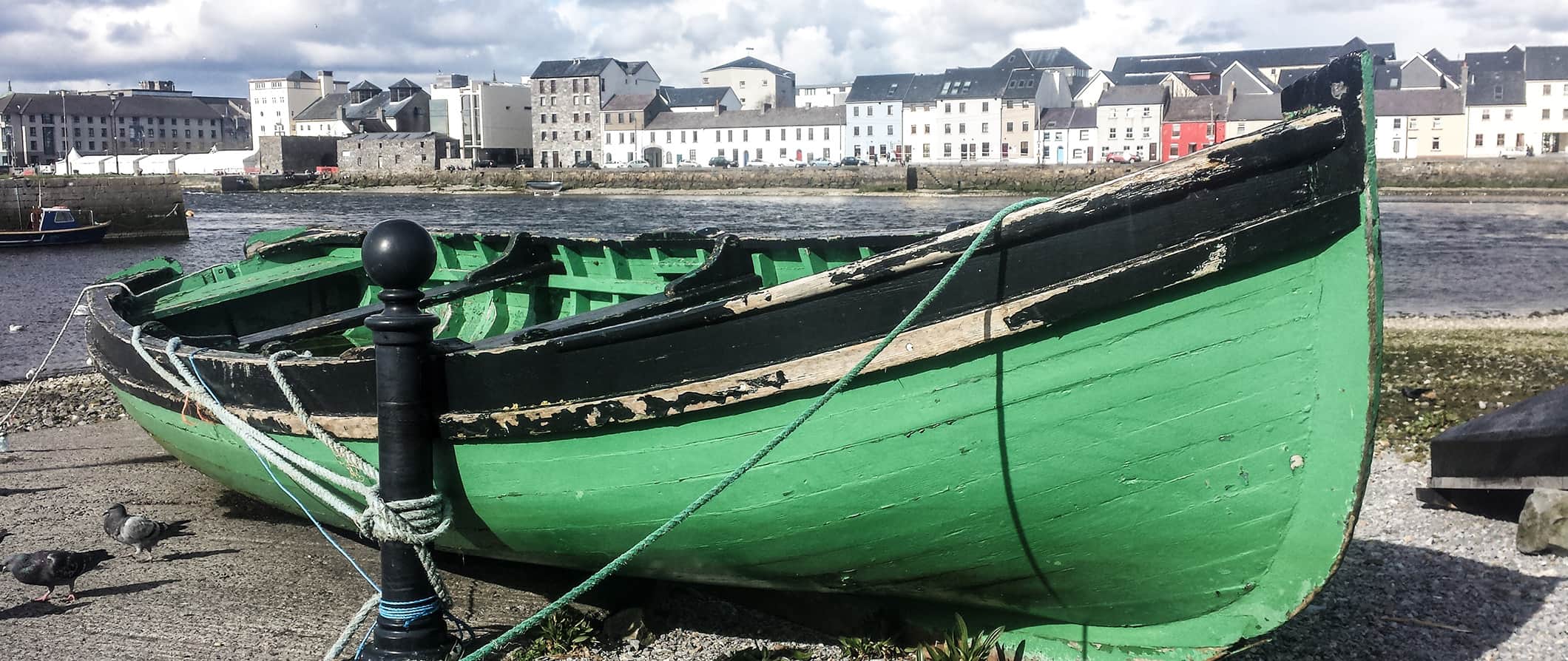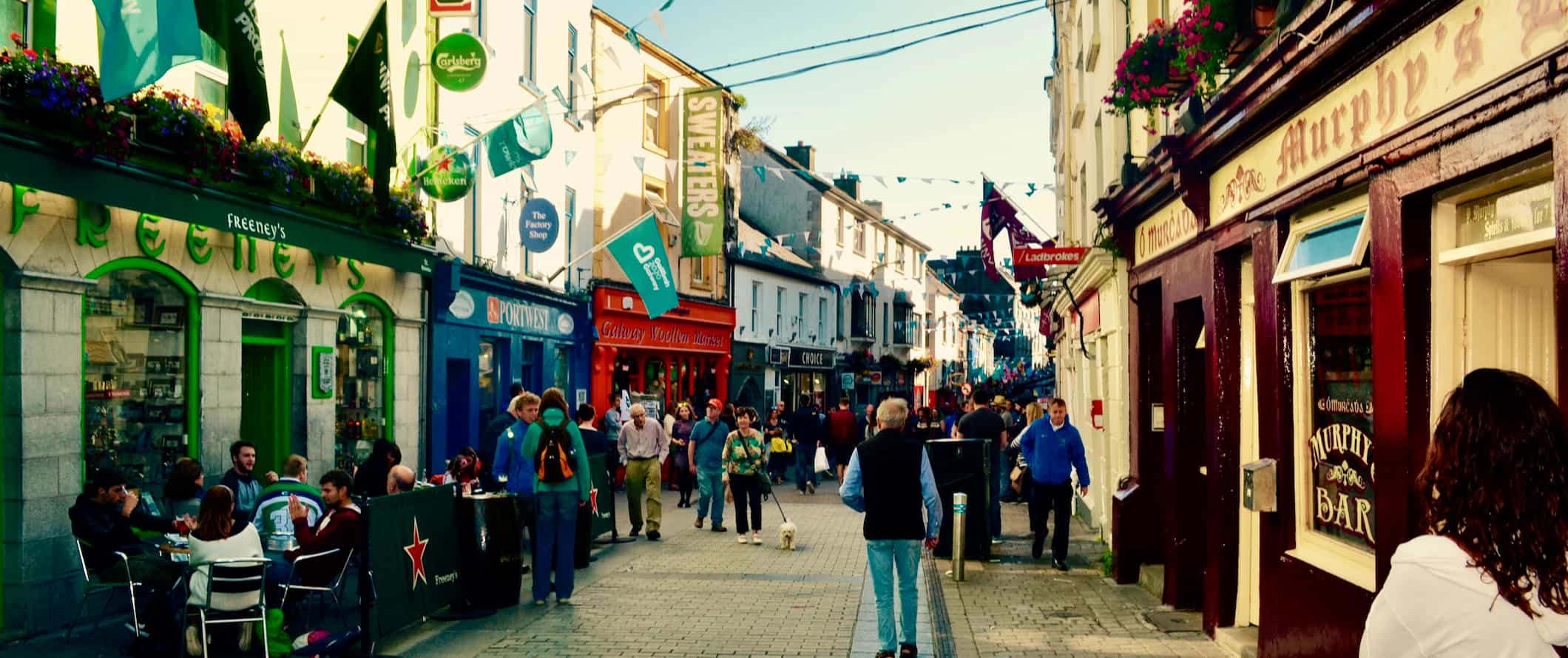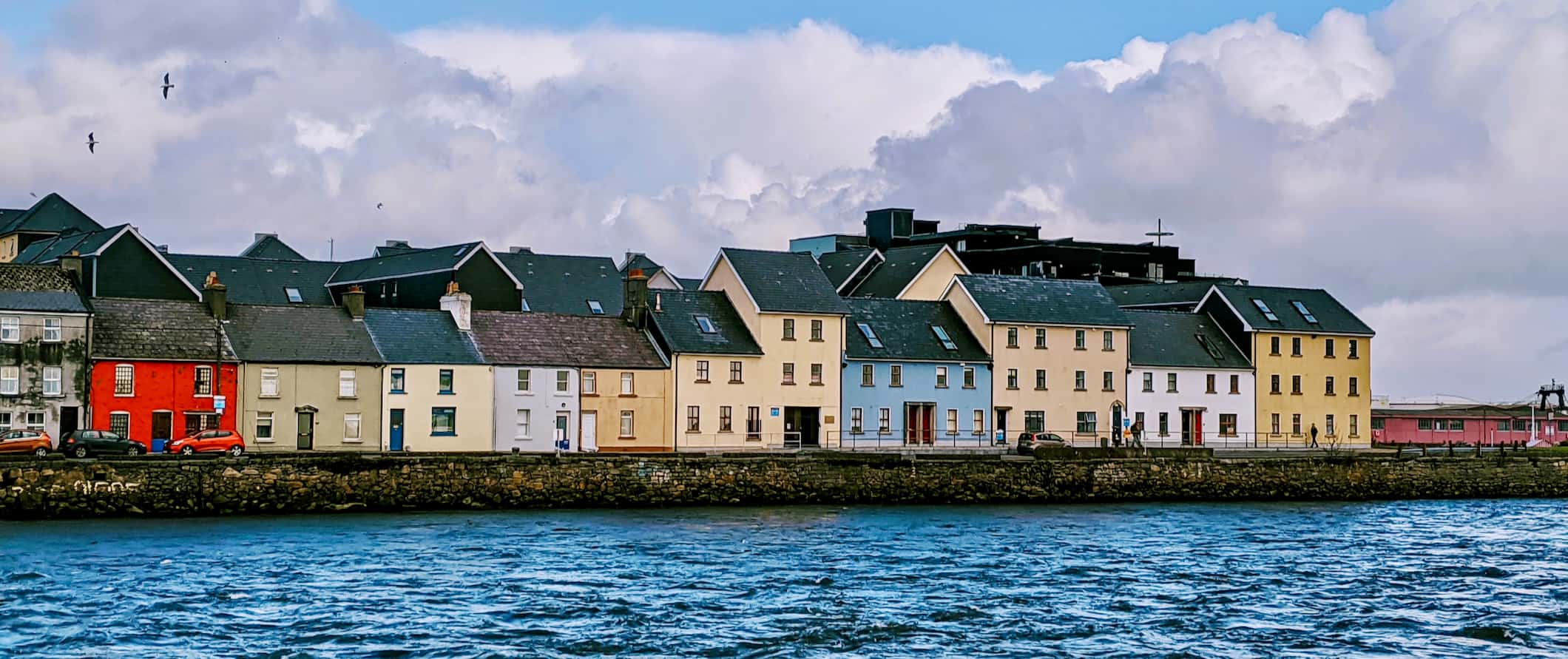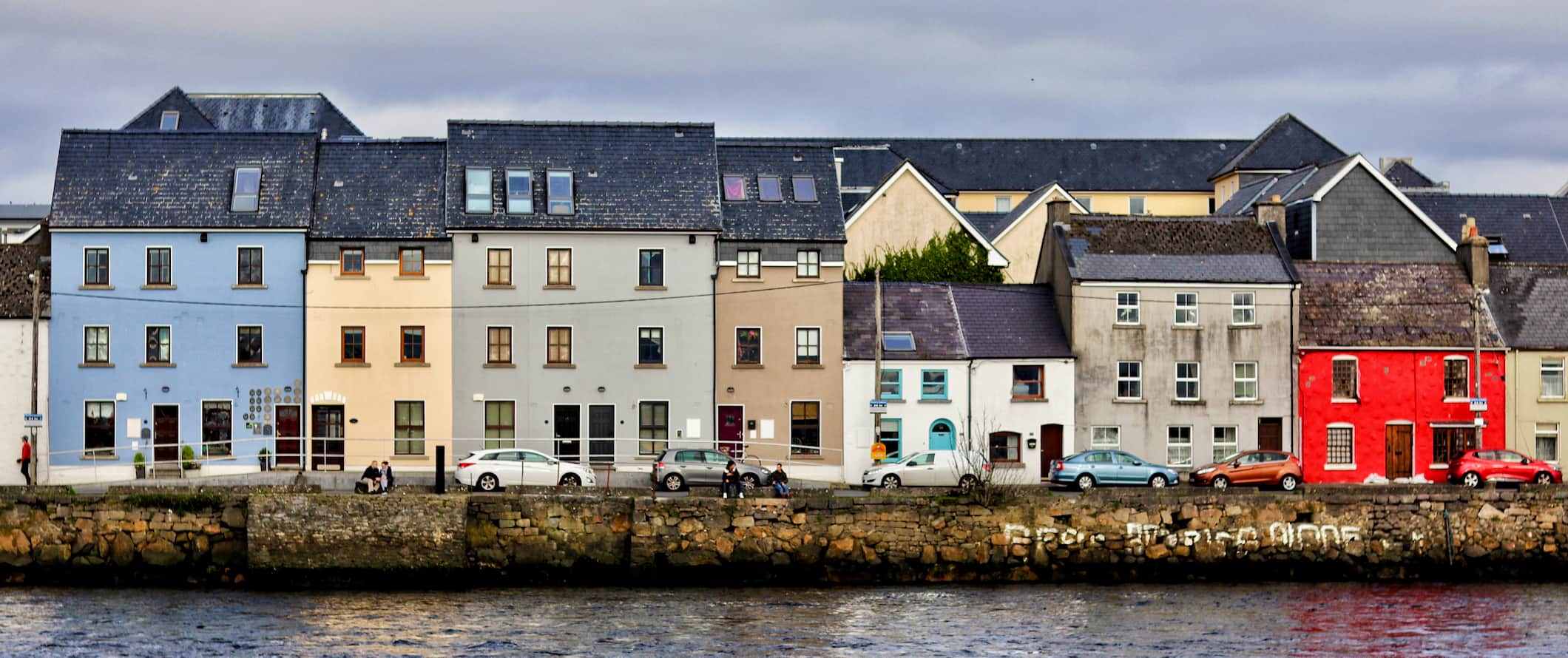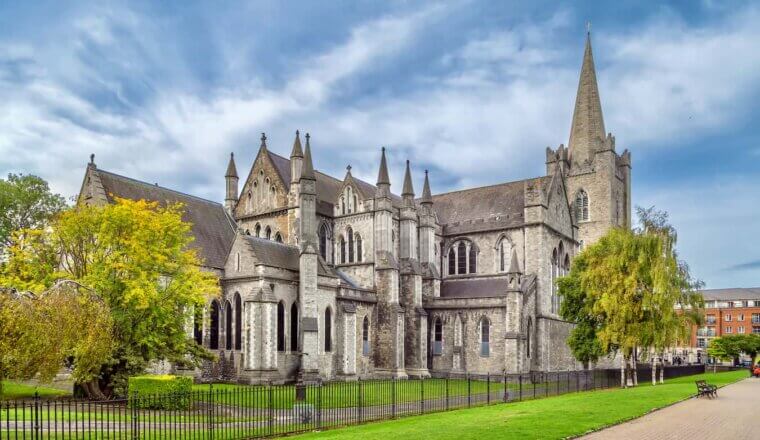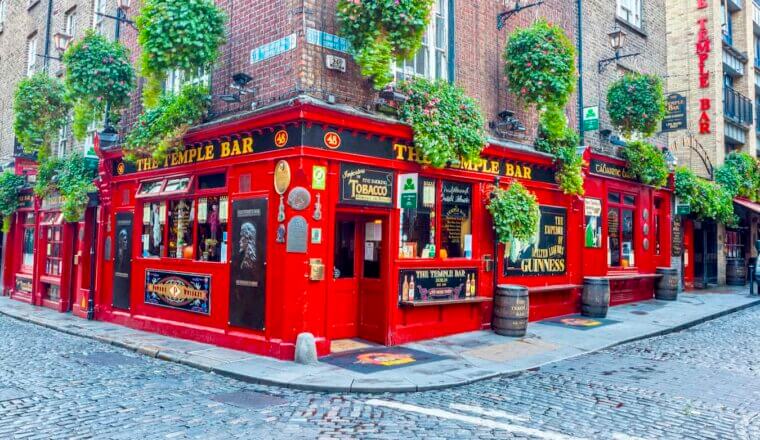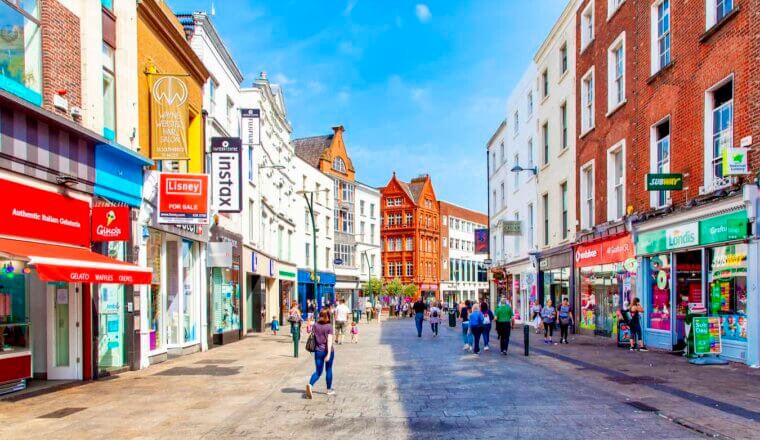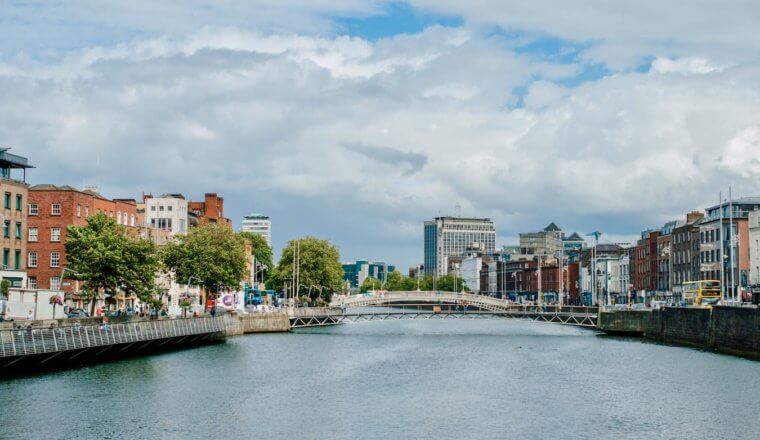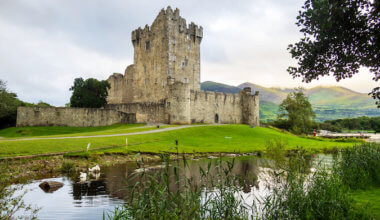On Ireland’s scenic west coast lies the college town of Galway. It’s my second favorite spot in the country behind Dublin. It may be small (just 80,000 people live here) but it’s packed with a lot to see and do.
There’s a historic city center, picturesque old churches, stunning coastal views, and an incredible pub culture (it is a college town in Ireland after all!).
It’s also a great jumping-off point for all kinds of day trips. From here you easily visit the Aran Islands and the Cliffs of Moher, two of Ireland’s most popular sights.
To me, Galway has everything you could ever want in an Irish city. It’s a perfect base for exploring the region, has a lively nightlife with many pubs playing traditional Irish music, a youthful feel thanks to the university, and has that charming small-town feel.
This travel guide to Galway can help you plan a budget-friendly trip and ensure you make the most out of your time here!
Table of Contents
Top 5 Things to See and Do in Galway
1. Wander the Salthill Promenade
The Salthill Promenade (known by locals as simply “The Prom”) is the place to go when you want to stretch your legs and take in the sea air of Galway Bay. What started as a rough, unpaved seaside road in the early 1900s blossomed into one of Galway’s gems beginning in the 1940s when a land surveyor improved the road and built seating and shelters along the path. The entire walkway offers picturesque views of the coast and is dotted with colorful shops and pubs. Stretching 2 kilometers (1.25 miles), Salthill Promenade begins at the edge of Galway City and ends at the Blackrock Diving Tower landmark. During the summer months, you’ll see lots of swimmers jumping off the tower into the sea. It’s a great place to catch sunrises and sunsets any time of year.
2. Take a day trip to the Cliffs of Moher
The Cliffs of Moher are an hour’s drive from Galway. They have some of the most stunning views of the ocean in all of Ireland. Their name comes from the Gaelic word Mothar which means “ruins of a fort.” O’Brien’s Tower, which sits atop the cliffs, was constructed using the original fort’s stone in 1835. At their highest point, the cliffs tower 214 meters (702 feet) above the sea and they stretch on for 14 kilometers (8.6 miles). You can rent a car or book one of the many (touristy) bus tours for about 45 EUR. It’s usually very foggy so try to save this for a sunny day if you can.
3. Visit the Galway Cathedral
While many of Europe’s cathedrals date back to the Middle Ages, this cathedral has only been around since the 1960s, making it one of the newest of Europe’s great stone cathedrals. The massive dome reaches a height of 44 meters (145 feet) and is one of the most stunning buildings in the city and an iconic addition to the skyline. It’s built of Galway limestone rather than concrete and, instead of the typical altars and stained-glass windows, you’ll find colorful modern mosaics. Admission is free, with a suggested donation of 2 EUR.
4. Visit the Aran Islands
Take a ferry to this group of three islands that lie off the coast. Only about 1,300 people call the Aran Islands home, and most of them still speak Gaelic, the original language in Ireland. It is known as a place of serenity, spirituality, and rejuvenation which has attracted artists from around the world. Rent a bicycle or walk along the craggy walking trails and between historic ruins like the Bronze Age ringfort of Dun Aengus which dates back to the 15th century. This is a full-day activity with ferry tickets costing 30 EUR.
5. Tour the Kilmacduagh Monastery
These abbey ruins in the nearby small town of Gort belong to a 7th-century monastery. Sometimes referred to as the Seven Churches, Saint Colman mac Duagh was believed to have established the original monastery after being gifted the land by King Guaire Aidne mac Colmain. The monastery became increasingly well known during medieval times, and in the 12th century, it became a bishop’s seat. It was finally ruined after multiple attacks and raids by William de Burgh in the 13th century. The round tower is the most impressive ruin and was painstakingly repaired in the late 1800s. It’s 34.5 meters (113 feet) and is the tallest in Ireland. It has only one doorway, which is 7 meters (23 feet) above the ground. Nobody knows for certain what it was for, but it may have been a bell tower or defensive structure.
Other Things to See and Do in Galway
1. Take a free walking tour
One of the best ways to get oriented in a new city is to take a free walking tour. I start all my trips off with one. Tribes Tours of Galway has incredibly knowledgeable guides who can teach you all about the city’s history and culture. You can also get all kinds of insider tips and suggestions that you won’t find in a guidebook. Just be sure to tip! They also run a pub crawl for 15 EUR.
2. Wander the Latin Quarter
This is the cultural heart of the city. It’s full of shops and pubs and there are usually buskers performing here when the weather is nice too. It’s the best place to wander and get a feel for the city — day or night! Don’t miss the Spanish Arch, an 18th-century arch that was once part of the city’s walled fortifications.
3. See the Glengowla Mines
If you want to understand what life was like for a 19th-century citizen of Galway, visit the Glengowla Mines. This museum is built on the site of a silver and lead mine so visitors can take a mine tour, watch a sheepdog herding demonstration, pan for gold, and learn how traditional peat houses were made. It’s a great place to visit if you’re traveling with kids as it’s both fun and educational. Admission is 12 EUR.
4. Visit the Burren Nature Sanctuary
The Burren Nature Sanctuary is a 50-acre organic farm located 30 minutes from Galway in Kinvara. It’s made up of meadows, woodlands, and even a lake. It also has a “Botany Bubble,” a type of greenhouse where flora from different climates (even the Arctic) grows alongside Irish wildflowers. You can stroll the nature trails, walk through the ancient ash and hazel forest, and hang out with some friendly farm animals like sheep and goats. Admission is 8 EUR.
5. Visit St. Nicholas’ Collegiate Church
Founded in 1320 CE, this is the largest medieval parish church in Ireland. The church is like a mini-museum and tours highlight its important artifacts, including its 400-year-old baptismal fountain. The exterior of the church is adorned with mermaids, a dragon, an ape, and a lion (all of which are pretty unique for a church!). The church also offered the first public blessing for a same-sex couple in Ireland back in 2002. Tours are free but need to be arranged in advance. Be sure to dress respectfully.
6. Tour the Sheep and Wool Centre
This family-friendly museum in the Connemara area outside of Galway is dedicated to textiles. It showcases the process of wool production, from the sheep to the finished garment. It also highlights the historical importance of sheep and wool in Irish culture as they were pivotal to survival in Ireland over the centuries. Admission is 10 EUR.
7. Visit the Galway Atlantaquaria
This is the national aquarium of Ireland. It’s located in Salthill, just two kilometers west of Galway. Here, the various aquariums show off the sea life that lives in the Atlantic. There are over 170 species in the aquarium, including sharks, rays, and seahorses. The aquarium also contains a massive fin whale skeleton as well as a 5,500-year-old Neolithic dugout canoe predating the pyramids of Egypt. Admission is 14 EUR.
8. Get your history fix
The Galway City Museum is a free local museum that provides an overview of the social history of the city. Exhibits focus on prehistoric and medieval Galway, as well as more modern cultural and material history. There are regular free gallery tours, talks, and workshops, so check the website beforehand to see what’s on.
9. Listen to live music
Galway is the perfect place to experience live traditional Irish music. Walk around the center of Galway and you’ll hear music pouring out of pubs all over the place. All you have to do is walk around and follow the music and you’ll be treated to an evening of Irish craic (“good times”).
For more information on other cities in Ireland, check out these guides:
Galway Travel Costs
Hostel prices – During the peak summer season, a bed in a 4-6-bed dorm costs around 42 EUR. A bed in a larger dorm with eight beds or more costs 30-32 EUR. During the off-season, dorms of all sizes cost around 30 EUR. Private rooms start at 90 EUR per night (prices don’t change between peak season and off-season). Free Wi-Fi is standard and most hostels also have self-catering facilities so you can cook your own food.
For those traveling with a tent, basic plots for two people without electricity can be found outside the city for 15 EUR per night.
Budget hotel prices – Budget hotels start at 120 EUR per night for a double room in a three-star hotel in the center of town. In the off-season, the same room can be found for around 100 EUR. Expect basic amenities like free Wi-Fi, TV, and a coffee/tea maker.
Airbnb is available in the city, with private rooms starting at 40 EUR per night. For an entire home or apartment, expect to pay at least 90 EUR per night.
Food – Ireland is very much a “meat and potatoes” country. Potatoes have been a common staple since the 18th century, along with seafood (it’s an island after all!). Cod, salmon, and oysters are some of the most popular seafood options, with other staple dishes being shepherd’s pie, black pudding, bacon and cabbage, fish and chips, and meat stews. Food is generally filling and hearty, though not always the healthiest.
A traditional meal costs around 15 EUR. For a multi-course meal with a drink, expect to pay at least 30 EUR. Fast food (think McDonald’s) starts at 9 EUR for a combo meal.
Pizza costs 11 EUR for a large while Chinese food costs around 10-12 EUR for a main dish. You can find fish and chips for under 10 EUR. Beer is 5.50 EUR while a latte/cappuccino is 3.50 EUR. Bottled water is 1.50 EUR.
If you want to cook your meals, expect to pay 40-60 EUR per week for groceries that include basic staples like pasta, rice, produce, and some meat or fish.
Backpacking Galway Suggested Budgets
On a backpacking budget of 70 EUR per day, you can stay in a hostel dorm, cook all your meals, limit your drinking, take public transportation to get around, and do free activities like free walking tours, exploring the Latin Quarter, and listening to live music. If you plan on drinking, add 5-15 EUR per day to your budget.
On a mid-range budget of 150 EUR per day, you can stay in a private hostel room or Airbnb, eat out for some meals at cheap fast food places, have a couple of drinks, take the occasional taxi, and do more paid activities visiting the Cliffs of Moher and the City Museum.
On a “luxury” budget of at least 295 EUR per day, you can stay in a hotel, eat out anywhere you want, drink more, rent a car for day trips, and do as many tours and excursions as you want. This is just the ground floor for luxury though. The sky is the limit!
Galway Travel Guide: Money-Saving Tips
Galway is one of the cheaper cities in Ireland. Being a college town, there are plenty of affordable shops, activities, and restaurants. But there’s always room to save more! Here are some tips to help you save in Galway:
- Eat pub food – It’s filling, it’s hearty, and, best of all, it’s affordable. Galway is brimming with pubs of all shapes and sizes, so walk around until you find one with a good atmosphere and an even better crowd.
- Drink less – Ireland’s pub culture can pummel your wallet. Temper the cost by visiting happy hours, drinking at home, or making a pint last the whole night. Since Galway is a student town, there are many pubs and happy hours to lower your spending.
- Stay with a local – Couchsurfing connects you with locals who can give you a free place to stay and help you learn about the city. It’s the best way to connect with locals.
- Take a free walking tour – To get a feel for the city and learn some history, be sure to take a free walking tour. It’s the best way to get the lay of the land on a budget.
- Eat early – Many restaurants have budget dinner options if you eat early (usually before 6pm). You won’t have as much variety since it’s a set menu, but it will be cheaper!
- Bring a water bottle – The tap water here is safe to drink so bring a reusable water bottle to save money and reduce your plastic use. LifeStraw is my go-to brand as their bottles have built-in filters to ensure your water is always clean and safe.
Where to Stay in Galway
If you’re looking to visit Galway on a budget, here are my recommended places to stay:
How to Get Around Galway
Public transportation – Galway is a very small city and you can walk just about anywhere. However, there is a local bus service if you need it. Single tickets cost 2.20 EUR. You can get a weekly pass for 17 EUR.
If you already have a LEAP card from another city visit, you can also use it in Galway on the bus system.
Bicycle – Galway’s bicycle sharing program is Coca-Cola Bikes (seriously). There are stations all over the city, with a three-day pass costing 3 EUR. With that pass, the first 30 minutes of your ride are free, and then it’s 0.50 EUR per half hour after that.
Taxi – Taxis aren’t cheap. Base fares are 4.15 EUR and then it’s 1.83 EUR per kilometer after that. Skip the taxis if you can!
Ridesharing – Uber has just launched here but, since the city is so small, you can likely skip it to save money.
Car rental – Car rentals can be found for as little as 25 EUR per day for a multi-day rental. However, you’ll only need a car if you’re leaving the city to explore. Drivers need to be at least 21 years old. Just remember that they drive on the left here.
For the best car rental prices, use Discover Cars.
When to Go to Galway
Although Galway has a mild, temperate climate, the city’s location on the North Atlantic means it can get quite cold here. There’s also a very good chance you’ll encounter some rain during your stay.
During the winter, temperatures drop below freezing so it’s not the ideal time to visit. However, prices drop and there are no crowds so as long as you stick to indoor activities you can still have an enjoyable visit.
The summer months (June-August) are the warmest, with temperatures averaging 18°C (66°F). However, keep in mind that this is peak season so you’ll compete for space in hostel dorms/hotels. Prices are slightly inflated during this time as well.
The shoulder seasons (spring and fall) are good times to visit, although temperatures are often chilly. You’ll experience fewer crowds, except around St. Patrick’s Day when the city fills up and things get rowdy. Book well in advance if you’re visiting in March.
If you plan on sticking to mostly indoor activities, visit during the shoulder season. However, if you want to explore the region and see the Cliffs of Moher then summer is your best bet.
How to Stay Safe in Galway
Galway is very safe and the risk of violent crime is low here. Pick-pocketing and petty theft can occur around high-traffic areas like the Spanish Arches in the Latin Quarter or on crowded public transportation so always keep your valuables out of reach just to be safe.
Scams here are virtually non-existent, but if you’re worried about getting ripped off you can read about common travel scams to avoid here.
Solo female travelers should generally feel safe here, however, the standard precautions apply (never leave your drink unattended at the bar, never walk home alone intoxicated, etc.).
If you rent a car, make sure no valuables are left in it overnight. Break-ins are rare but it’s better to be safe than sorry!
If you experience an emergency, dial 112 or 999 for assistance.
The most important piece of advice I can offer is to purchase good travel insurance. Travel insurance will protect you against illness, injury, theft, and cancellations. It’s comprehensive protection in case anything goes wrong. I never go on a trip without it as I’ve had to use it many times in the past. You can use the widget below to find the policy right for you:
Galway Travel Guide: The Best Booking Resources
These are my favorite companies to use when I travel. They consistently have the best deals, offer world-class customer service and great value, and overall, are better than their competitors. They are the companies I use the most and are always the starting point in my search for travel deals.
- Skyscanner – Skyscanner is my favorite flight search engine. They search small websites and budget airlines that larger search sites tend to miss. They are hands down the number one place to start.
- Hostelworld – This is the best hostel accommodation site out there with the largest inventory, best search interface, and widest availability.
- Booking.com – The best all around booking site that constantly provides the cheapest and lowest rates. They have the widest selection of budget accommodation. In all my tests, they’ve always had the cheapest rates out of all the booking websites.
- HostelPass – This new card gives you up to 20% off hostels throughout Europe. It’s a great way to save money. They’re constantly adding new hostels too. I’ve always wanted something like this and glad it finallt exists.
- Get Your Guide – Get Your Guide is a huge online marketplace for tours and excursions. They have tons of tour options available in cities all around the world, including everything from cooking classes, walking tours, street art lessons, and more!
- The Man in Seat 61 – This website is the ultimate guide to train travel anywhere in the world. They have the most comprehensive information on routes, times, prices, and train conditions. If you are planning a long train journey or some epic train trip, consult this site.
- Trainline – When you’re ready to book your train tickets, use this site. It streamlines the process of booking trains around Europe.
- Rome2Rio – This website allows you to see how to get from point A to point B the best and cheapest way possible. It will give you all the bus, train, plane, or boat routes that can get you there as well as how much they cost.
- FlixBus – Flixbus has routes between 20 European countries with prices starting as low 5 EUR! Their buses include WiFi, electrical outlets, a free checked bag.
- SafetyWing – Safety Wing offers convenient and affordable plans tailored to digital nomads and long-term travelers. They have cheap monthly plans, great customer service, and an easy-to-use claims process that makes it perfect for those on the road.
- LifeStraw – My go-to company for reusable water bottles with built-in filters so you can ensure your drinking water is always clean and safe.
- Unbound Merino – They make lightweight, durable, easy-to-clean travel clothing.
- Top Travel Credit Cards – Points are the best way to cut down travel expenses. Here’s my favorite point earning credit cards so you can get free travel!
Galway Travel Guide: Related Articles
Want more info? Check out all the articles I’ve written on backpacking/traveling Ireland and continue planning your trip:
